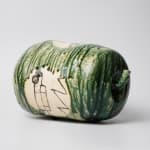Suzuki Goro 鈴木五郎 Japanese, b. 1941
Oribe Sculpture "Togan(Water Melon)" 絵織部 冬瓜, 2003
Oribe Glazed Stoneware
H6.8” x W10.6”
H17.5 x W27 cm
H17.5 x W27 cm
Signed Go 五 at the back
With Signed Wood Box
With Signed Wood Box
Sold
Further images
-
(View a larger image of thumbnail 1
)

-
(View a larger image of thumbnail 2
)

-
(View a larger image of thumbnail 3
)

-
(View a larger image of thumbnail 4
)

-
(View a larger image of thumbnail 5
)

-
(View a larger image of thumbnail 6
)

-
(View a larger image of thumbnail 7
)

-
(View a larger image of thumbnail 8
)

-
(View a larger image of thumbnail 9
)

-
(View a larger image of thumbnail 10
)

-
(View a larger image of thumbnail 11
)

-
(View a larger image of thumbnail 12
)

-
(View a larger image of thumbnail 13
)

-
(View a larger image of thumbnail 14
)

-
(View a larger image of thumbnail 15
)

-
(View a larger image of thumbnail 16
)

-
(View a larger image of thumbnail 17
)

-
(View a larger image of thumbnail 18
)

-
(View a larger image of thumbnail 19
)

-
(View a larger image of thumbnail 20
)

-
(View a larger image of thumbnail 21
)

-
(View a larger image of thumbnail 22
)

-
(View a larger image of thumbnail 23
)

-
(View a larger image of thumbnail 24
)

This playful piece by the master ceramicist Suzuki Goro boasts an excellent traditional Oribe green glaze. Oribe ware holds a unique place in Japanese ceramics, originated in 17th century, largely...
This playful piece by the master ceramicist Suzuki Goro boasts an excellent traditional Oribe green glaze. Oribe ware holds a unique place in Japanese ceramics, originated in 17th century, largely produced in Mino area. One of its characteristic geometric and organic designs on a burnt orange field coupled with areas of rich green glaze are immediately recognizable. Here on Suzuki's water melon, the high contrast between orange and green provides a nice visual "pop," and their successful pairing requires a carefully maintained temperature during firing. The green glaze does not seem dry at all, but rather retains an exuberantly liquid sheen and pools thickly in the irregularities of the surface as well as in the corners of the box's interior. These jewel-like pools emphasize the gentle undulations of the surface, cut by the artist into beautiful organic lines. The orange sections contain the typical Oribe countryside designs, including woven bamboo, twisting vines, hanging fruits, and the artist's own signature flying crow. The box has an ancient pedigree in Japanese art, but Suzuki's boxes transcend this history by creating something wholly new and individual. Suzuki Goro's work can be found in numerous public and private collections, including the Metropolitan Museum of Art, New York; the Museum of Fine Art, Boston; the Japanese Ceramics Museum, and many others. Suzuki's playful and engaging work proves his position as a master of the ceramic arts, as this commanding box beautifully illustrates.
Share
- X
- Tumblr

























